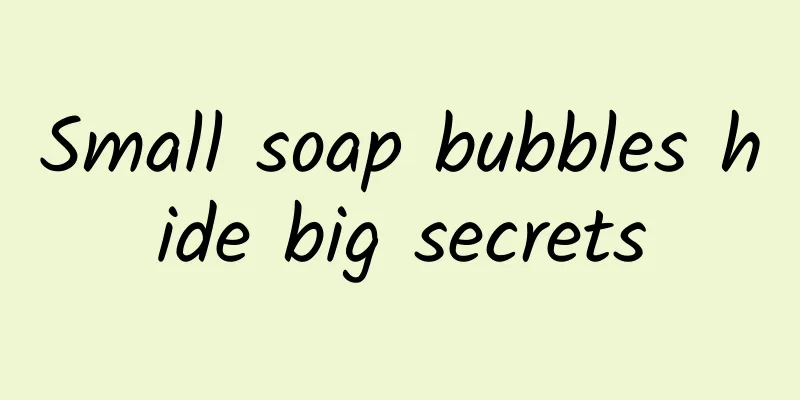Small soap bubbles hide big secrets

|
Blowing bubbles is a small game we often played when we were young. Mix a certain amount of washing powder with clean water, stir evenly, dip a plastic ring in it, and blow gently. The bubbles will fly around with the spring breeze and be colorful under the sunshine. Image source: veer gallery It sounds simple, but have you ever wondered about these questions: Why can't clean water make bubbles? Why do soapy water look clear but bubbles are colorful in the sun? In fact, there is a lot of scientific knowledge hidden under the tiny bubbles. Today, let's get close to bubbles and explore their secrets. Part 1 The birth of bubbles: what is surface tension? The secret recipe of bubble water we usually use is actually very simple, just use hot water to dissolve soap or washing powder. So why can't plain water blow bubbles, but the soapy water we mix can? This starts with the principle of bubble formation. First of all, we need to understand a physical concept: surface tension. Have you ever noticed these phenomena: when raindrops fall on lotus leaves, they turn into round water droplets and roll around; some small animals can move freely on the water surface. They rely on the surface tension of water. Water drops on lotus leaves (Photo source: veer photo gallery) Water bugs (Photo source: veer photo gallery) The surface of a liquid has a tendency to shrink automatically, and the driving force for this automatic shrinkage comes from the different gravitational fields that the molecules experience inside and on the surface of the liquid. For the molecules on the surface of the liquid, the gravitational force from the internal liquid molecules is greater than the pulling force from the external air molecules. Therefore, when gravity can be ignored, the liquid has a tendency to shrink in area and always tends to form a sphere. On a macroscopic level, this force is called the surface tension of the liquid. Surface tension model (Image source: self-made by the author) At this point, some people may have a new question: surface tension makes the liquid surface area tend to shrink, so why do soap bubbles still exist? Good question, it is true. However, since surface tension does not allow air to exist in water, can't we form big bubbles by reducing the surface tension? Before explaining how to reduce surface tension, let's first re-understand soap and washing powder, which are also called "surfactants." Surfactants are a type of substance that easily attaches to interfaces and has a significant impact on the properties of interfaces and related process. From a historical perspective, surfactants originated from detergents. The most basic soap formula has a history of thousands of years. The ancient Roman writer Pliny was one of the first people to record this formula. According to his observation, the method of making soap is to mix oil and alkali, and the product of ash dissolved in water is a kind of alkali. Soap molecule: sodium fatty acid (Image source: self-made by the author) The alkalis used today are all artificially synthesized, but the soap molecules generated are similar to those in the past, consisting of a hydrophilic head group and a lipophilic tail group. Due to the repulsion between the lipophilic group and the water molecules, in order to seek the lowest energy form of existence, the surfactant molecules will first be arranged on the surface of the aqueous solution with the hydrophilic group facing downward (in contact with water molecules) and the lipophilic group facing upward (in contact with air molecules). Only when there is no space on the liquid surface to accept new surfactant molecules will the newly added surfactant molecules move into the solution. The hydrophilic group is attracted downward by the water molecules, but because the polarity of the hydrophilic group is weaker than that of the water molecules, this attraction is weaker than the attraction between water molecules; the lipophilic group is attracted upward by the air molecules, but because of its relatively large volume, the lipophilic group can come into contact with more air molecules, and the weaker polarity also enables the lipophilic group to better merge and attract the air molecules. This attraction is stronger than the attraction between air molecules and water molecules. In general, the downward gravitational force weakens and the upward gravitational force increases. The unbalanced force on the surfactant molecules is weaker than that on the water molecules. Therefore, the surface of the aqueous solution with surfactant molecules is obviously weaker than the surface of the water molecules alone. From a macroscopic point of view, the surface tension is reduced. This is why soapy water can blow bubbles. Soap bubble surface force model (Image source: self-made by the author) Part 2 Bubble colors: Where do the colors come from? When we blow bubbles in the sun, we will find that the color of the bubbles is as dynamic and colorful as water. In fact, soap bubbles are colorless. The reason why they show colorful colors in the sun is that the sunlight is reflected and interfered with the upper and lower surfaces of the transparent film. "Reflection" and "interference" are not uncommon in life. We can see ourselves in the mirror because of the reflection of light. Reflection refers to the phenomenon that when light propagates to different substances, it changes its propagation direction at the interface and returns to the original substance. Light will be reflected when it encounters the surface of water, glass and many other objects. Soap film is a transparent film with two surfaces, upper and lower. When sunlight shines on the surface of soap film, it will be reflected by the upper and lower surfaces of the film respectively. Physicists have shown that light, like the waves in a pond, has a strong wave nature. When you throw a stone into a pond, the ripples meet and interfere with each other to form beautiful patterns. If we look closely, we will find that the vibrations of some parts of the water waves are getting stronger, while the vibrations of other parts are getting weaker. In physics, we call the phenomenon of two or more waves superimposed or canceled out when they meet in space to form a new wave interference. Constructive Interference (Image source: self-made by the author) Destructive Interference (Image source: self-made by the author) Just like water waves, when light beams of the same frequency meet, they will also interfere with each other. It is worth mentioning that a film of a certain thickness can only make light of a certain wavelength produce stable constructive interference or destructive interference. The former refers to the peaks (or troughs) of the two waves arriving at the same place at the same time, and the interference wave will produce the largest amplitude. The latter refers to the peaks and troughs of the two waves meeting, which reduces the amplitude of the interference wave. The amplitude of the light wave reflects the intensity of the light, giving the human eye a sense of brightness or darkness. Interference Principle Model (Image source: self-made by the author) Since the thickness of the soap film is not uniform in different places, according to the theory of constructive interference and destructive interference, the sunlight will be strengthened, weakened, or canceled out on the film surfaces of different thicknesses, and the color will be red, blue, or green, making the soap bubbles appear colorful. Part 3 Inspiration from bubbles: Why so many studies come from it? Nowadays, there are many soap bubble enthusiasts in the world. They have established a global organization such as the "International Bubble Artists Association", which is dedicated to exploring the secret recipe of soapy water to blow bigger bubbles. They are even constantly refreshing the Guinness World Record for bubble size, responding to childhood dreams and yearning for big bubbles. Tiny soap bubbles hide the secrets of nature. Physicists use them to study surface tension, mathematicians use them to study minimum surfaces, biologists use them to study the biochemical mechanisms of thin films in organisms, and mechanics use them to study the inflation structure of thin films... Soap bubbles have made great achievements in the field of scientific research and have given scientists many inspirations. For example, in the early 20th century, German scholar Prandtl, while studying the torsion of elastic cylinders, discovered that the equation satisfied by the stress function in the cylinder was the same as the equation satisfied by the film under its own weight; and not long ago, Hamid Kelly, a fluid mechanics expert at the University of Bordeaux in France, used soap bubbles as an ideal model for studying atmospheric phenomena and put forward his own conjecture about the universal law of cyclone evolution; even a paper on the branched flow of light based on soap bubbles, "Observation of branched flow of light", was published on the cover of Nature. All this proves to us that soap bubbles still have many secrets worth exploring. As the famous British physicist Kelvin said, "Blow a soap bubble and observe it, you will spend your whole life studying it, and use it to draw out one physics lesson after another." The wonders and fun of nature are worth our lifetime exploration. References: [1] Catherine Nixey. Things in the Bubble[J]. The Romantic Generation, 2021(29):48-49. [2] Lin Bian, Luke. From the Void to the Practical: Small Soap Bubbles: Worth Your Lifelong Study[J]. World Expo, 2021(19):72-73. Produced by: Science Popularization China Produced in May Author unit: Changchun Institute of Optics, Precision Mechanics and Physics, Chinese Academy of Sciences Producer: Computer Network Information Center, Chinese Academy of Sciences (The images with source indicated in this article have been authorized) The article only represents the author's views and does not represent the position of China Science Expo This article was first published in China Science Expo (kepubolan) Please indicate the source of the public account when reprinting China Science Expo Please indicate the source of the reprint. Reprinting without authorization is prohibited. For reprint authorization, cooperation, and submission matters, please contact [email protected] |
<<: January 2022 "Science" Rumor List: Do pre-prepared meals contain preservatives?
Recommend
Use the buying volume mindset to sell goods through live streaming!
Once upon a time, everyone agreed that live strea...
Daily Youxian event traffic generation tips!
In the past, when we went to the supermarket to b...
The tragedy of Android phones: high scores but not as smooth as iPhones
Recently, Lei Jun's Weibo post about "Wh...
A “guide” to wasting money on advertising: How to spend 100 yuan like 1 yuan?
There is a famous saying in the advertising indus...
Taobao store group refined single category product selection ideas [Video course] (with Xiaoer picture downloader and picture splitter)
Taobao store group refined single category produc...
What is the core of what Liu Genghong said? Don’t wait until you get hurt to understand!
Mixed Knowledge Specially designed to cure confus...
Smart connected cars will become the next trend in the market. Can Netqin Link successfully promote traffic reform?
After the emergence of new energy vehicles led by...
Cognition and scale—how do operations intervene in products?
Products and operations may indeed conflict over ...
Android Fragment uses full parsing
The use of Fragment is a commonplace~~~ 1. Overvi...
A guide to entering and starting broadcasting on Douyin Box!
My friends, will you use Douyin box instead of Ta...
Is 3D Touch being ignored by game developers just because there are too few iPhone 6s users?
For the iPhone 6S, which is known as "the on...
This chemical has been banned for decades, but it still endangers the lives of killer whales
In the 2023 Nature Photographer of the Year compe...
Launching a special health code for the elderly: Ministry of Industry and Information Technology requires WeChat, Alipay and other payment services to be adapted for the elderly
[[375494]] As the elderly population in my countr...
What are the functions of the Guangzhou home furnishing and building materials mini program? How much does it cost to develop a building materials delivery mini program?
In recent days, we have received a lot of inquiri...
A case study on efficient advertising and customer acquisition optimization in the beauty industry!
With the development of society, the growth momen...









